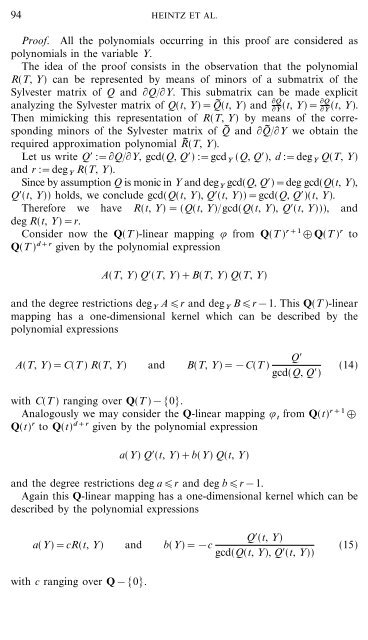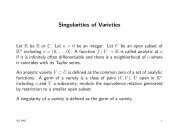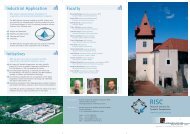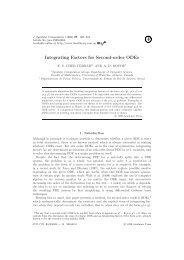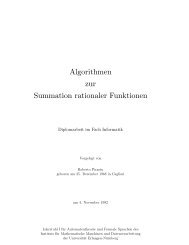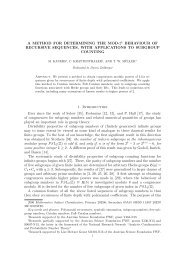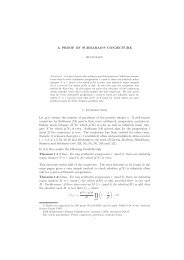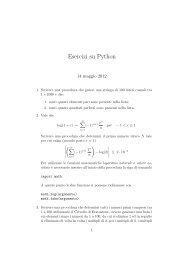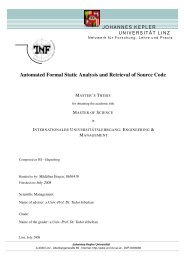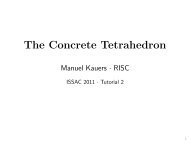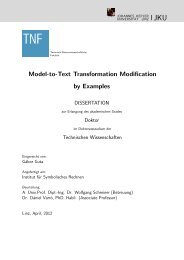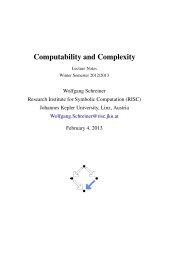Deformation Techniques for Efficient Polynomial Equation ... - RISC
Deformation Techniques for Efficient Polynomial Equation ... - RISC
Deformation Techniques for Efficient Polynomial Equation ... - RISC
Create successful ePaper yourself
Turn your PDF publications into a flip-book with our unique Google optimized e-Paper software.
94 HEINTZ ET AL.<br />
Proof. All the polynomials occurring in this proof are considered as<br />
polynomials in the variable Y.<br />
The idea of the proof consists in the observation that the polynomial<br />
R(T, Y) can be represented by means of minors of a submatrix of the<br />
Sylvester matrix of Q and QY. This submatrix can be made explicit<br />
analyzing the Sylvester matrix of Q(t, Y)=Q (t, Y) and Q<br />
Y<br />
(t, Y)=Q<br />
Y<br />
(t, Y).<br />
Then mimicking this representation of R(T, Y) by means of the corresponding<br />
minors of the Sylvester matrix of Q and Q Y we obtain the<br />
required approximation polynomial R (T, Y).<br />
Let us write Q$:=QY, gcd(Q, Q$) :=gcd Y (Q, Q$), d :=deg Y Q(T, Y)<br />
and r :=deg Y R(T, Y).<br />
Since by assumption Q is monic in Y and deg Y gcd(Q, Q$)=deg gcd(Q(t, Y),<br />
Q$(t, Y)) holds, we conclude gcd(Q(t, Y), Q$(t, Y))=gcd(Q, Q$)(t, Y).<br />
There<strong>for</strong>e we have R(t, Y)=(Q(t, Y)gcd(Q(t, Y), Q$(t, Y))), and<br />
deg R(t, Y)=r.<br />
Consider now the Q(T )-linear mapping . from Q(T ) r+1 Q(T ) r to<br />
Q(T ) d+r given by the polynomial expression<br />
A(T, Y) Q$(T, Y)+B(T, Y) Q(T, Y)<br />
and the degree restrictions deg Y Ar and deg Y Br&1. This Q(T )-linear<br />
mapping has a one-dimensional kernel which can be described by the<br />
polynomial expressions<br />
A(T, Y)=C(T ) R(T, Y) and B(T, Y)=&C(T )<br />
Q$<br />
gcd(Q, Q$)<br />
(14)<br />
with C(T ) ranging over Q(T )&[0].<br />
Analogously we may consider the Q-linear mapping . t from Q(t) r+1 <br />
Q(t) r to Q(t) d+r given by the polynomial expression<br />
a(Y) Q$(t, Y)+b(Y) Q(t, Y)<br />
and the degree restrictions deg ar and deg br&1.<br />
Again this Q-linear mapping has a one-dimensional kernel which can be<br />
described by the polynomial expressions<br />
a(Y)=cR(t, Y) and b(Y)=&c<br />
Q$(t, Y)<br />
gcd(Q(t, Y), Q$(t, Y))<br />
(15)<br />
with c ranging over Q&[0].


